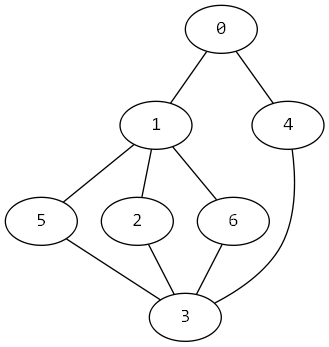Counting roundtrip paths in a graph given a number of steps
This problem appeared in a SO question asking for help converting a recursive \( O(N^k) \) solution into a bottom-up dynamic programming one \( O(kN^2) \) where k is the number of allowed steps and N is the number of nodes in a graph.
As noted on the post given a sample graph

and setting \( k = 5 \) yields a total of 6 possible roundtrip paths from the origin node
0-1-2-3-4-0
0-1-5-3-4-0
0-1-6-3-4-0
0-4-3-6-1-0
0-4-3-5-1-0
0-4-3-2-1-0
The code to solve the problem is posted in the answer I gave, anyway I’ll repost it for convenience
/**
* Count the number of ways we can go from station 0 to station destination
* traversing exactly nSteps edges with dynamic programming. The algorithm
* runs in O(k*N^2) where k is the number of tickets and N the number of
* stations.
*/
unsigned int tripCounter(const Subway& subway, int destination, int nSteps)
{
map<int, vector<int>> m;
for (int i = 0; i < nSteps + 1; ++i)
m[i].resize(subway.nStations, 0);
m[0][0] = 1; // Base case
for (int t = 1; t < m.size(); ++t) { // For each ticket
vector<int> reachedStations;
for (int s = 0; s < subway.nStations; ++s) { // For each station
if (m[t-1][s] > 0)
reachedStations.push_back(s); // Store if it was reached in the previous state
}
for (auto s : reachedStations) {
// Find adjacent stations
for (int adj = 0; adj < subway.nStations; ++adj) {
if (s == adj)
continue;
if (subway.connected[s][adj])
m[t][adj] += m[t-1][s];
}
}
}
return m[nSteps][0];
}The algorithm assumes an adjacency matrix to store the subway graph.